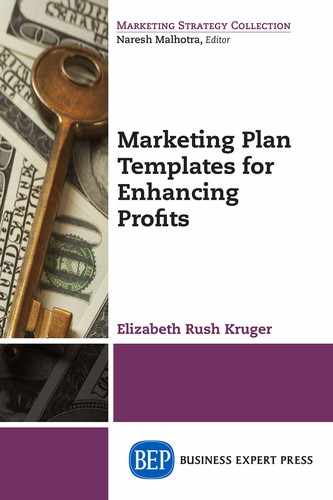Overview
A mentor and her protégé discuss how to work less yet earn more. The mentor says, “This book will coach you to identify your high-quality prospects so you can be as successful as I am.”
Her secret is similar to the timeless wisdom in one of Aesop’s fables, “Quality not quantity counts.” Dr. Kruger’s experiment confirms that Aesop’s wisdom is true. In fact, scientists consistently find that the top 20 percent of the inputs produce 80 percent of the results.
Let’s learn how to use this 80/20 rule to provide a high-quality solution to problems facing customers and to define this opportunity as the mission of the business.

Starbucks1
Vignettes
A Mentor Reveals How to Spark Profits
Early on a Monday morning, two independent distributors are enjoying lattes at Starbucks. The novice jests about her latest encounters and her mentor shares photos of her family’s weekend jaunt.
After enjoying their rapport and lattes, her mentor asks, “How is the prospecting coming along?”
Smugly, the novice heaves her list of prospects across the table.
With a scornful toss of her hair, her mentor says, “I have only a few prospects.”
The novice sips her latte and then asks, “Why do you have so few prospects? I contact lots of prospects, hoping a few will buy from me.”
Building up suspense, her mentor says, “I easily convert most of my prospects into customers.”
Taken aback, the novice says. “I work hard to convert a few of my prospects into customers.”
“I can predict who will become customers and who will buy the premium items.”
Astonished, the novice gulps her latte and says, “My buyers threaten to switch to a lower-priced competitor. What’s your secret?”
“Besides, I know who will continue to buy from me.”
Muttering into her empty mug, the novice says, “I end up with a mess of complaints—and low commissions. Why don’t you tell me your secret?”
“I can even predict who will become highly profitable customers. I know how to work less, yet consistently earn high commissions.”
“Please tell me how to work less and earn more.”
Having piqued her interest, her mentor whispers in her ear, “Quality not quantity counts. Focus on high-quality prospects and your commissions will soar. Quality is the key to sparking your profits.”
Eagerly, the novice asks, “But who are my high-quality prospects?”
Skirting the question, her mentor says, “We’re in different businesses, so my top prospects are different from yours.” Her mentor opens her briefcase and gives her Marketing Plan Templates for Enhancing Profits. “This book will coach you to identify your high-quality prospects so you can be as successful as I am.”
Timeless Wisdom
This chapter, like all chapters in this book, begins with a vignette that is similar to one of Aesop’s fables. Many believe that a Greek slave named Aesop told fables in the sixth century BC on the island of Samos in the eastern Aegean Sea. Aesop’s fables became popular. Soon partygoers were sharing his humor with friends, and lawyers were using Aesop’s wisdom to argue cases. The popularity of Aesop’s fables spread throughout Western civilization and their wisdom still resonates in our lives today.2

A Hellenistic statue depicting Aesop3
Will a Lion Cub Rule as King?
An Aesop Fable
A vixen leads her litter of little foxes up to a lioness and sneers, “You only bore one cub.”
Tossing her head in scorn, the lioness roars, “Only one, but he will rule as king of the animals.”
Aesop observed that quality produces better results than quantity. “Do not judge merit by quantity, but by worth. Quality not quantity counts.”
Quality Beats Quantity
Does Quality Really Count?
The vixen bore a quantity of little foxes, but the lioness bore one high-quality cub. In modern jargon, a vixen is an ill-tempered and flirtatious woman, whereas a lioness is a woman who is exceptional at everything she does, from taking care of her family to running a business venture.
Aesop’s fable about a princely lion cub and a litter of foxes conveys that quality is better than quantity. However, businesses usually count the quantity, not the quality of their customers.
Does quality count in a business? Do a few high-quality customers produce more profits than a large quantity of the other customers? Read on and you will discover why I know that your answer will be “Yes.”

Elizabeth Kruger conducting a workshop4
I Learn from My Own Workshop
At one of my workshops5, I boldly stated:
Let’s see if quality counts more than quantity. Our inputs will be the people in this room and our results will be what? We’ll pull them out of a hat. Just to be outlandish, they will be—hats. We’ll see if a few people own most of the hats.
Explaining the experiment, I said:
We’ll define “high-quality” hat owners as possessing many hats and “low-quality” hat owners as possessing only a few hats. We’ll rank everyone in the room in sequential order by how many hats they own. Will a few high-quality hat owners possess most of the hats and a large quantity possess just a few hats? If so, then quality not quantity counts.
Starting off, I remarked:
I love to walk on the beach, play tennis, and ski, so I own a variety of hats—sun hats, tennis visors, and ski caps. I suppose I own about 15 hats. At least we’re not counting shoes.
I asked each person in the room to report how many hats they own. A participant recorded their answers in sequential order and reported that the 20 people own 26 hats.
Figure 1.1 ranks the respondents by their hat ownership on the horizontal axis. The left axis shows with bars how many hats they own. The right axis accumulates these results as a percentage of the total.
Since I own 15 of the 26 hats, I own 57 percent of the hats. Together with the 3 who own 2 hats, we own most of the hats. The other 16 people own only 5 hats.
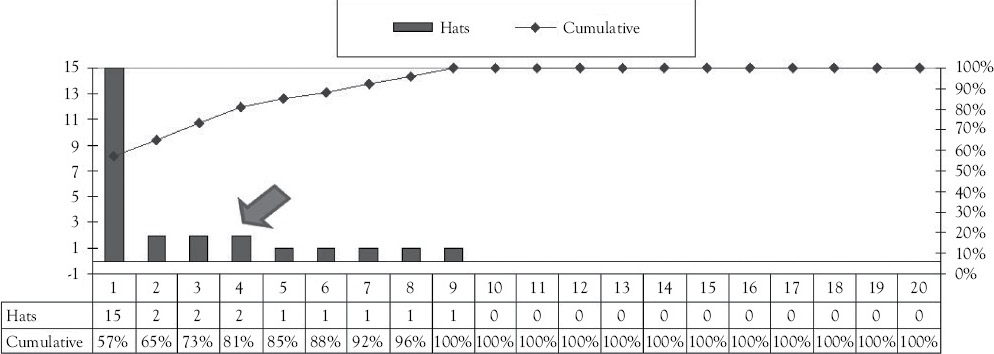
Figure 1.1 Hat owners
Table 1.1 Hat owners
|
Hat owners |
People |
Percentage of people |
Hats |
Percentage of hats |
|
High quality |
4 |
20% |
21 |
81% |
|
Low quality |
16 |
80% |
5 |
19% |
|
Total |
20 |
100% |
26 |
100% |
Table 1.1 shows that our small sample biased our results a little. These results show that 20 percent of the people own 81 percent of the hats, while 80 percent of the people own 19 percent of the hats.
I remarked, “Quality not quantity counts for hats so we can conclude that quality does count.”
Scientific Results
Scientists consistently find a similar curve when they relate a large random sample of inputs and their results. For example, Gunther Eysenbach analyzed the tweeting of information in 2011 (Figure 1.2).
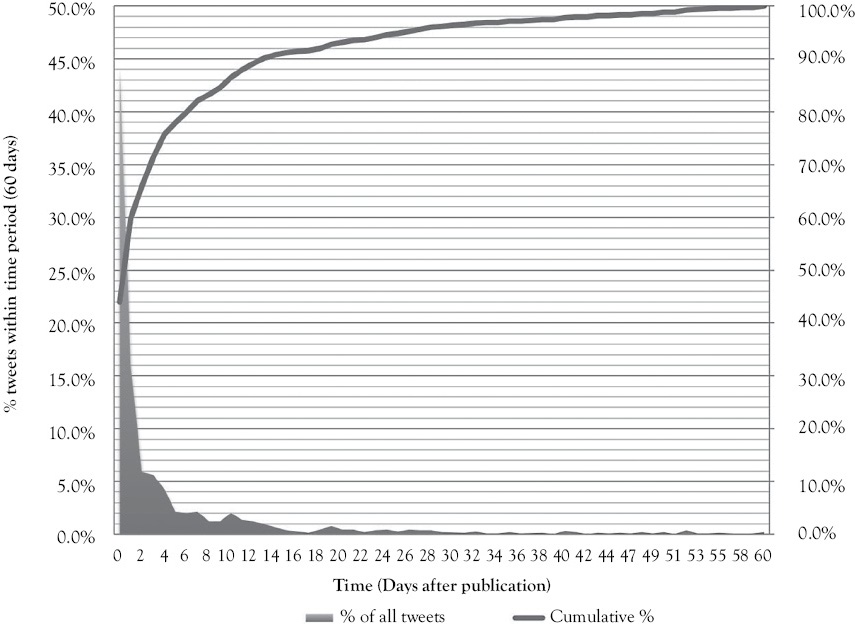
Figure 1.2 Tweets
The horizontal axis indicates the first 60 days after publishing the information. The left axis shows the rate of new tweets per day, while the right axis accumulates the percentage of tweets. We see that the tweeting drops off quickly, with 60 percent of the tweets occurring in just the first two days.6
How Much Does Quality Count?
Pareto Discovered a Consistency
Aesop taught that “quality not quantity counts,” and two millennia later, Vilfredo Pareto discovered just how much quality counts. Pareto was the Professor of Political Economy at the University of Lausanne in Switzerland. His brilliance attracted students from throughout Europe. Pareto was the founder of macroeconomics and advocated capitalism, free trade, and laissez-faire (less) government.7,8

Vilfredo Pareto9
In 1897, Vilfredo Pareto researched the effect of quality on results. He analyzed economic, social, biological, and environmental data. When Pareto sequenced inputs by their results, he discovered an amazing consistency that his students named the 80/20 rule:10
What Is the 80/20 Rule?
According to the 80/20 rule, the top 20 percent of the inputs will produce 80 percent of the results, whereas the bottom 80 percent of the inputs will produce only 20 percent of the results. Based on overwhelming evidence, Pareto concluded that the 80/20 rule applies to virtually all data.
Vilfredo Pareto had discovered how to predict results. For example, the 80/20 rule predicts that the top 20 percent of customers will produce 80 percent of the profits, whereas the bottom 80 percent of the customers will produce only 20 percent of the profits (Figure 1.3).11
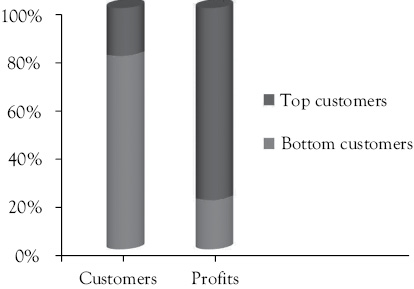
Figure 1.3 Types of customers
Another way to look at the data is to rank inputs along a horizontal axis and accumulate results along a vertical axis. In Figure 1.4, the top 20 percent of the inputs will produce 80 percent of the results, whereas the bottom 80 percent of the inputs will produce 20 percent of the results.
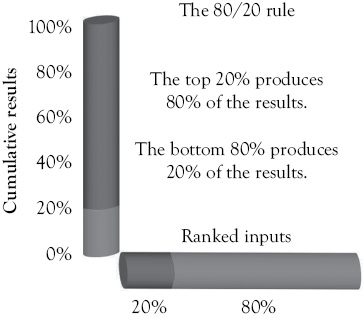
Figure 1.4 Prediction of results
Does the 80/20 Rule Predict Results?
You can test whether the 80/20 rule actually does predict results. Just analyze a random sample of at least 60 inputs in three simple steps:
- Rank your inputs in sequential order by the size of their results.
- Identify the top 20 percent and bottom 80 percent of your inputs.
- Total the results and see if the top 20 percent of the inputs produced 80 percent of the results. If so, you have shown that the 80/20 rule is a universal law that predicts results.
Key #1: Focus on Quality

Doris Kearns Goodwin12
In the race for quality there is no finish line.
Doris Kearns [Goodwin], a Pulitzer Prize-winning biographer of American presidents.
Opportunities to Focus on Quality
How Can a Business Focus on Quality?
According to the 80/20 rule, a business that offers high-quality products and services will be more profitable than a business that offers low-quality items. When a business offers high-quality items, it can rule its market like a regal lioness.
The first step in focusing on quality is to revisit the mission of the business. Are you sure the business offers a high-quality solution to a problem? Solving a problem is a business opportunity.
What Opportunities Are Trending?
There are six types of opportunities facing a business: demographic, economic, natural, technological, political, and cultural opportunities. Here are some examples of global trends that can be an opportunity for a business.
Demographic Trends
- Women are making more major purchase decisions.
- Growing numbers of elderly in developed countries need health care, pharmaceuticals, medical equipment, and health care facilities.
- The high birth rate of Muslims is leading to the construction of more mosques.
- More immigration is fueling the need for translators and bilingual teachers.
Economic Trends
- Despite inflation, the wealthy continue to buy real estate, fine art, and luxuries.
- Inflation drives unemployed people and those on fixed income to ration their necessities.
- Increasing poverty drives the poor to patronize discount stores, buy home entertainment, and live in an apartment.
Natural Trends
- New vehicles emit less air pollution and are more energy efficient than the older models.
- Droughts are increasing the demand for water-efficient toilets, showerheads, and sprinklers.
- Coal-burning factories are scrubbing the air from smoke stacks or switching to cleaner sources of energy.
Technological Trends
- More people are demanding the latest computers, cell phones, and tablets.
- Online learning is becoming the norm for children, college students, and professionals.
- The military is now using drones to combat terror.
Political
- Elections are becoming more expensive.
- The demand for lawyers is increasing.
- There is more advocacy advertising.
Cultural
- A rising birth rate among single mothers increases their need for daycare, entitlements, and flexible work schedules.
- Muslim communities are imposing sharia law within self-sufficient areas.
- Instead of working, more people are involved in criminal activities like the drug trade, human slavery, and extortion.

The Tri-Glide Freewheeler13
How Did Harley-Davidson Respond to These Opportunities?
Harley responded to the needs of women, the elderly, and tech-savvy drivers with innovations in their 2015 lineup of motorcycles.
- The Electro Glide Ultra (Classic or Limited) Low model is for drivers who are less than 67 inches tall. (Women tend to be shorter than men.)
- The Tri-Glide Freewheeler model provides more stability for elderly drivers.
- The Road Glide Special model offers tech-savvy drivers integrated audio and navigation systems with touchscreen controls.14
What Is a Mission Statement?
How Does a Business Define Its Mission?
A business cannot control trends in the macroenvironment, but it can capitalize on them. The mission of a wise business is to provide a quality solution to a trending problem.
A mission statement of a business should be practical, achievable, and specific. Ideally, a mission statement should specify the enduring vision for the business. However, its slogan must inspire the employees and attract the target market. These are examples of mission statements and slogans (Table 1.2).15
Table 1.2 Mission statements and slogans
|
Business |
Overview |
Mission |
Slogan |
|
ADM, Decatur, IL |
Globally the number one processor of oilseeds, corn, wheat, soybean, peanut, and other similar products. |
To unlock the potential of nature to improve the quality of life. |
Resourceful by nature |
|
Bristol-Myers Squibb Company, New York, NY |
Manufactures pharmaceutical drugs and other health care products. |
To discover, develop, and deliver innovative medicines that help patients prevail over serious diseases. |
Extending and enhancing human life |
|
CVS Corporation, Woonsocket, RI |
Distributes health care products such as pharmaceutical drugs in over 5,375 stores in 36 states. |
We will be the easiest pharmacy retailer for customers to use. |
Expect something extra |
|
Dollar General Corporation, Goodlettsville, TN |
Having more than 7,700 discount stores in around 30 states, retails household items to low-, middle-, and fixed-income customers. |
Serving others, respect, and opportunity |
Save time. Save money. Dollar General. |
|
Ford Motor Company, Dearborn, MI |
The innovator in mass production manufactures Ford, Lincoln, Mercury, Mazda, Volvo, Jaguar, Land Rover, and Aston Martin automobiles. |
We are a global family with a proud heritage passionately committed to providing personal mobility for people around the world. |
Built for the road ahead |
|
Global Gillette Prudential, Boston, MA |
Manufacturer of shaving equipment, specializing particularly in razors, blades and batteries, including Sensor, Trac II, Mach3, M3Power, Fusion, and Duracell |
We will provide branded products and services of superior quality and value that improve the lives of the world’s consumers |
Welcome everyday solutions |
Summary
According to the 80/20 rule, the top 20 percent of the inputs will produce 80 percent of the results, whereas the bottom 80 percent of the inputs will produce only 20 percent of the results. This means a business that offers high-quality products and services will be more profitable than a business that offers low-quality items.
The mission of a business should be to offer a high-quality solution to a problem of its target market. There are demographic, economic, natural, technological, political, and cultural trends in the macroenvironment. These opportunities inspire the mission of a business. Thus, the first key to enhancing profits is for the mission of a business to focus on quality.
 The Mission of the Business Is to Focus on Quality
The Mission of the Business Is to Focus on Quality
The mission of the business should reflect what it does best.
Who are the customers of the business?
□ Businesses
□ Consumers
□ Government agencies
□ Nonprofit organizations
What type of problem does the business solve?
□ Cultural |
□ Economic |
□ Political |
□ Demographic |
□ Natural |
□ Technological |
What benefit does the business offer them?
□ Entertain |
□ Help |
□ Provide |
□ Exercise |
□ Lead |
□ Teach |
□ Fulfill |
□ Protect |
What items does the business provide?
□ Information |
□ Products |
□ Services |
Decide how the business will focus on quality:
- What problem will the business solve for its key customers?
- The mission of a business is to assist (customers) to overcome a (problem) to (benefit) them with (items). (Be specific).
- Summarize the mission of the business with a catchy slogan.
